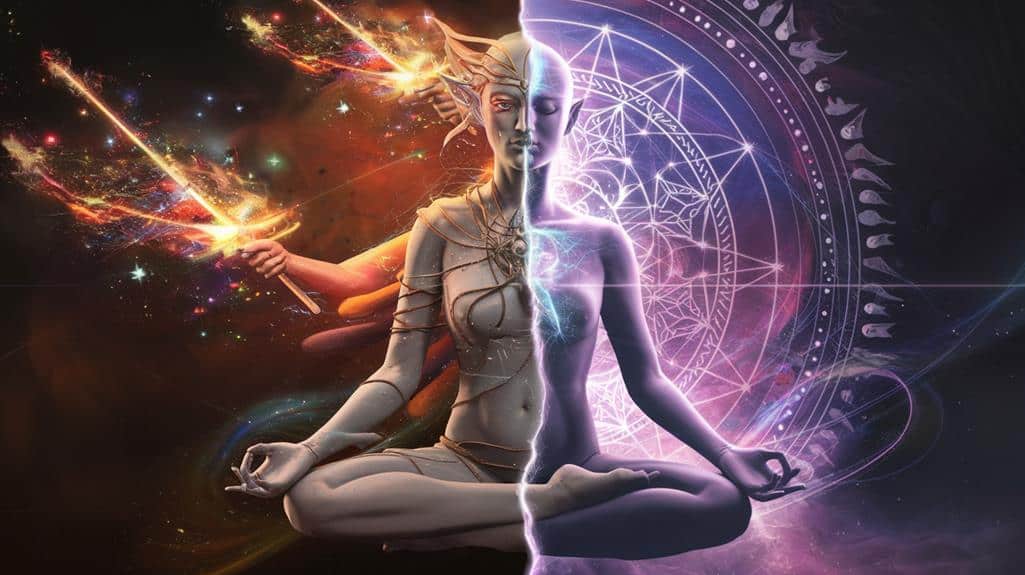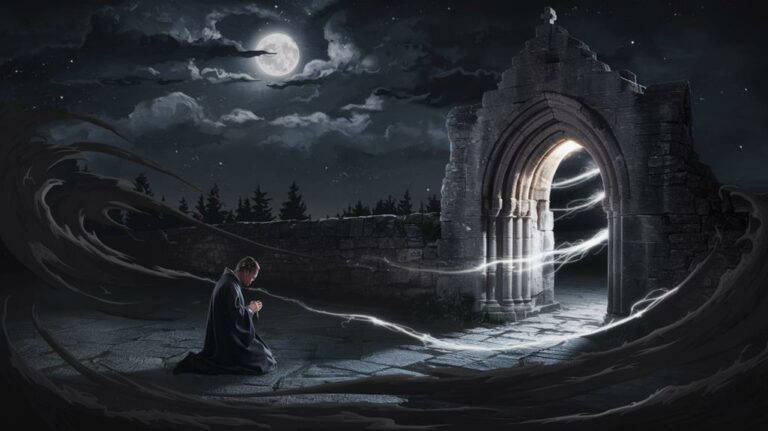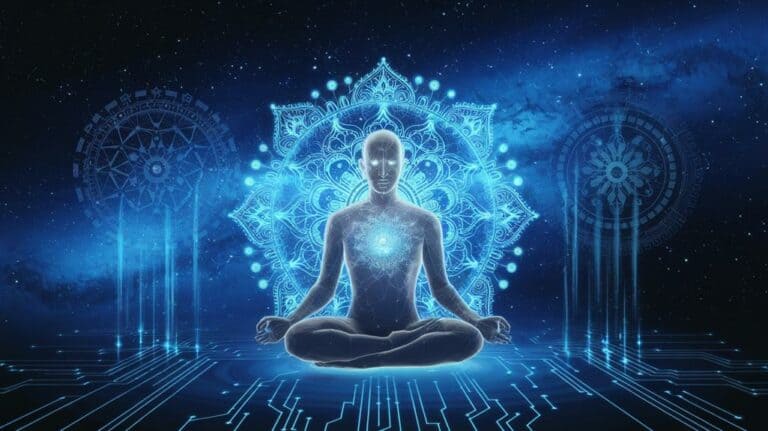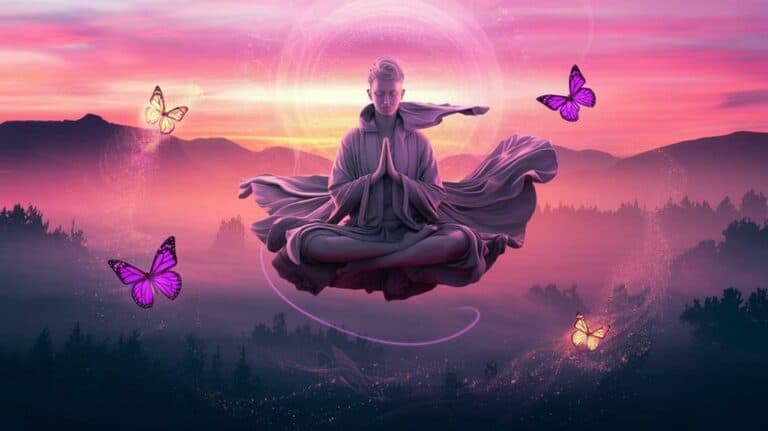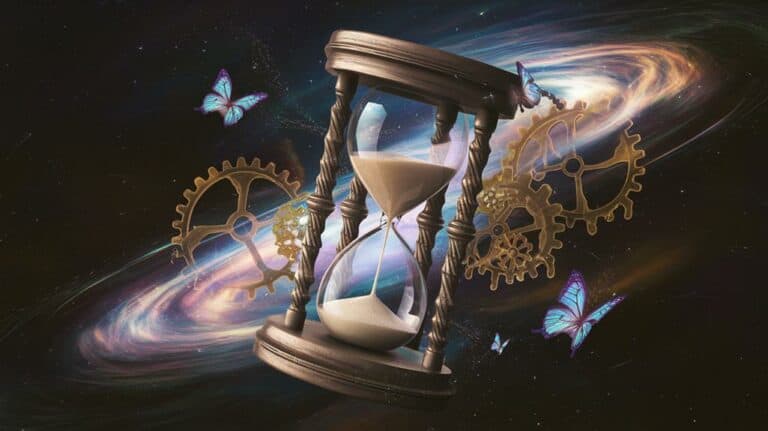Difference Between Magic and Mysticism
When you’re exploring the domains of spiritual practice, you’ll find that magic and mysticism often get lumped together, but they’re as different as a locksmith and a philosopher. While both deal with supernatural forces, their approaches couldn’t be more distinct. You might think of magic as the art of manipulating external energies to achieve specific results—like turning a key to access a door. Mysticism, however, is more like dissolving the door altogether through inner transformation. As these ancient traditions continue to influence modern spiritual seekers, understanding their fundamental differences will help you navigate their complex territories.
Historical Origins and Development
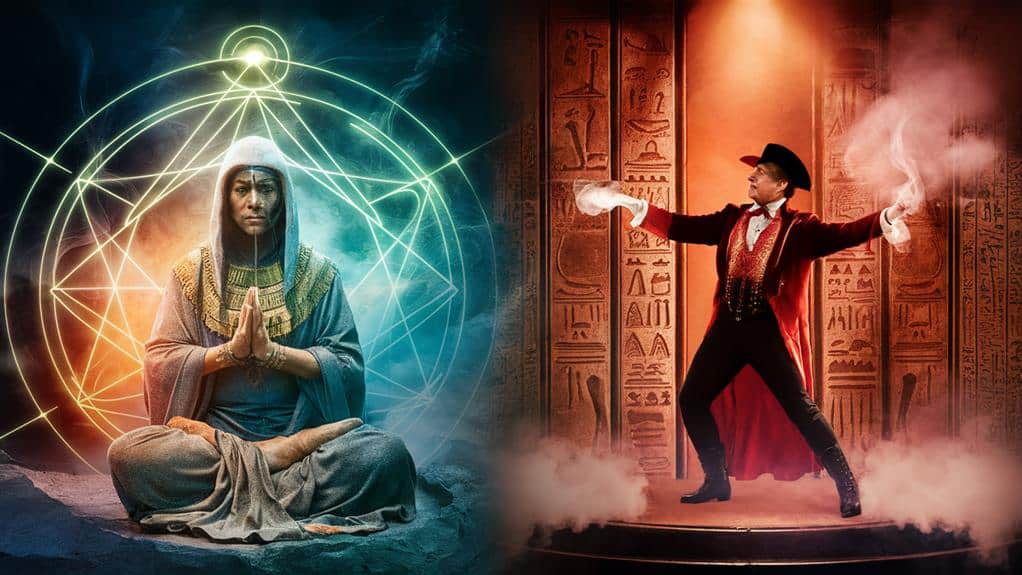
The historical origins of magic and mysticism trace back to humanity’s earliest civilizations, though they emerged through distinctly different paths.
You’ll find that while magic developed as a practical attempt to control natural and supernatural forces through rituals, spells, and ceremonies, mysticism evolved as an intimate quest to directly experience and unite with divine reality.
In ancient Mesopotamia, Egypt, and other early societies, you’d have witnessed magic practitioners developing sophisticated systems of correspondences between objects, words, and desired outcomes.
They’d create intricate grimoires and spell books, believing they could manipulate reality through precise formulas.
Meanwhile, mystical traditions emerged through contemplatives who’d withdraw into temples, caves, and wilderness spaces, seeking transcendent union through meditation, prayer, and ascetic practices.
As you explore deeper, you’ll discover that while magical traditions often passed through hereditary lineages or selective initiatory schools, mystical paths frequently arose spontaneously across cultures, sparked by individuals who’d experienced profound spiritual awakenings.
These parallel developments continue to influence how you might approach the supernatural today, offering two distinct paradigms for engaging with reality beyond the ordinary.
Core Philosophies and Beliefs
Building upon these historical foundations, magic and mysticism embrace fundamentally different worldviews and approaches to supernatural engagement.
In magic, you’ll find an emphasis on directing and controlling supernatural forces through specific techniques, rituals, and formulas to achieve desired outcomes. You’re basically positioning yourself as an active agent who can manipulate the hidden forces of the universe through knowledge and will.
Mysticism, however, leads you down a markedly different path. Rather than seeking control, you’ll discover it’s about surrendering to and merging with the divine or ultimate reality. As a mystic, you’re not trying to bend supernatural forces to your will; instead, you’re dissolving the boundaries between yourself and the transcendent.
You’ll find that mysticism’s core philosophy centers on direct, personal experience of the divine through contemplation, meditation, and inner transformation.
While magic empowers you to change external circumstances through supernatural means, mysticism invites you to transform your consciousness and experience oneness with the divine.
The magician works with tools and formulas; the mystic works with consciousness and surrender.
Methods and Practices
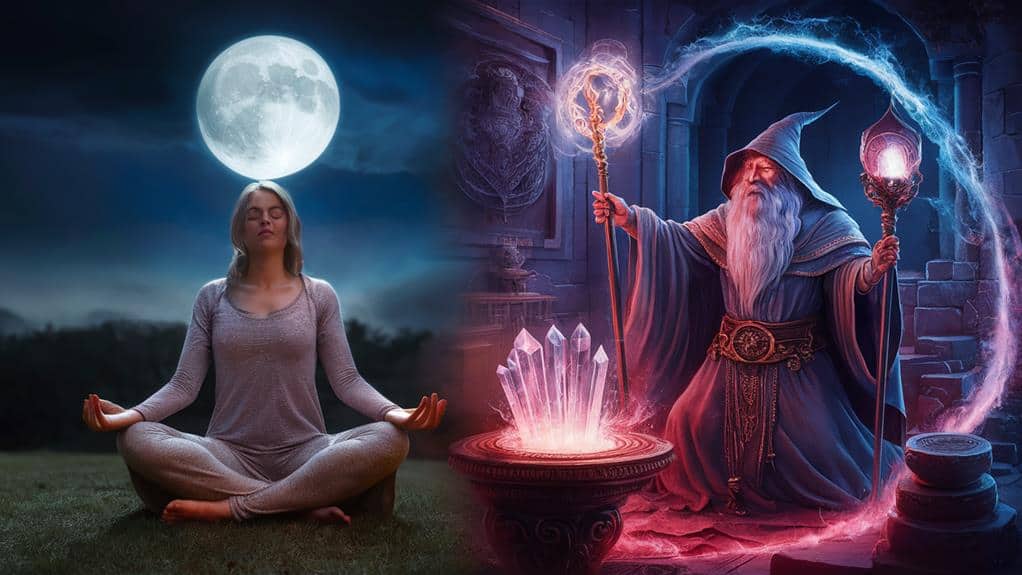
Various practical methods distinguish magic from mysticism in their day-to-day applications.
When you engage in magical practices, you’ll find yourself working with specific tools, incantations, and ritualistic procedures designed to manifest particular outcomes in the physical world. You’ll often rely on grimoires, spell components, and carefully timed ceremonies that follow precise formulaic structures.
In contrast, when you pursue mysticism, you’ll discover it emphasizes internal transformation through meditation, contemplation, and direct spiritual experience. You won’t need elaborate tools or external objects; instead, you’ll focus on practices like breath work, mindfulness, and sustained inner observation.
While magic seeks to bend external reality to your will, mysticism invites you to dissolve the boundaries between your consciousness and the divine.
The mystic’s path leads you through states of progressively deeper awareness, often involving practices of self-denial and ego transcendence. You’ll find that unlike magic’s emphasis on achieving specific results, mystical practices guide you toward union with the absolute, where the distinction between practitioner and practice ultimately dissolves into pure being.
Goals and Expected Outcomes
Fundamental differences emerge when examining the desired outcomes of magical and mystical practices. While you’ll find that magic typically seeks to manifest specific changes in the material world – whether it’s attracting prosperity, influencing events, or healing ailments – mysticism pursues a radically different endpoint.
Your magical workings might focus on achieving tangible results that you can measure and observe, but mystical practice leads you toward dissolution of the very self that desires such outcomes.
When you engage in mystical practices, you’re not trying to gain or achieve anything in the conventional sense. Instead, you’re working toward transcendence of ordinary consciousness and union with what mystics describe as ultimate reality.
You’ll discover that while magic empowers you to shape your external circumstances, mysticism invites you to release your attachment to outcomes altogether.
The mystic’s journey draws you toward states of consciousness where the distinction between subject and object dissolves, and you’re left with direct experience of what various traditions call the Divine, the Absolute, or Pure Awareness.
Cultural Impacts Through Time
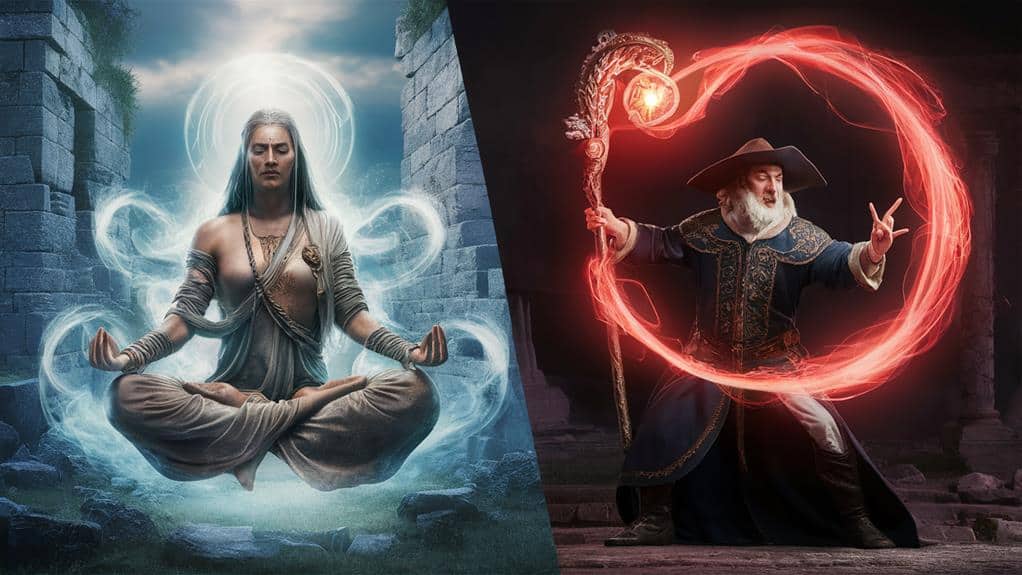
Both magic and mysticism have profoundly shaped human societies throughout recorded history, though their influences have manifested in markedly different ways. You’ll find magic’s impact woven into the fabric of everyday life – from ancient Egyptian amulets to medieval grimoires – where it’s served as a practical tool for those seeking to influence their immediate world.
In contrast, mysticism’s cultural footprint reveals itself through contemplative traditions that have transformed religions and philosophical movements across civilizations.
When you examine medieval Europe, you’ll notice how magic often emerged as a grassroots phenomenon, spreading through villages and towns as people sought solutions to daily struggles.
Meanwhile, mysticism flourished in monasteries and spiritual communities, producing profound theological works that continue to influence modern spiritual thought.
In the East, you’ll discover how mystical traditions like Sufism and Zen Buddhism have shaped art, literature, and architecture, while magical practices became integrated into folk religions and healing traditions.
Today, you’re witnessing a revival of both paths, as people increasingly seek alternatives to conventional spirituality, though they’re now expressing themselves through modern interpretations and digital platforms.
Sacred Texts and Traditions
Sacred writings and traditions reveal stark differences between magical and mystical approaches to the divine. When you explore magical texts, you’ll find detailed instructions, precise formulas, and specific rituals designed to manifest desired outcomes through supernatural forces. These writings often promise direct control over natural and spiritual domains, presenting step-by-step methods you can master through dedicated practice and precise execution.
In contrast, mystical texts guide you toward dissolution of the ego and surrender to divine wisdom. You won’t find formulaic approaches in the writings of great mystics like Rumi, Meister Eckhart, or the anonymous author of “The Cloud of Unknowing.” Instead, they’ll lead you through profound contemplations that strip away your assumptions about control and mastery.
While magical grimoires detail ways to bend reality to your will, mystical manuscripts emphasize letting go of your will entirely.
You’ll discover that sacred Buddhist sutras, Kabbalistic texts, and Sufi poetry all point toward direct experience of ultimate reality through self-transcendence, rather than manipulation of external forces. These traditions suggest that true power lies not in controlling the divine, but in becoming one with it.
Practitioners and Their Roles
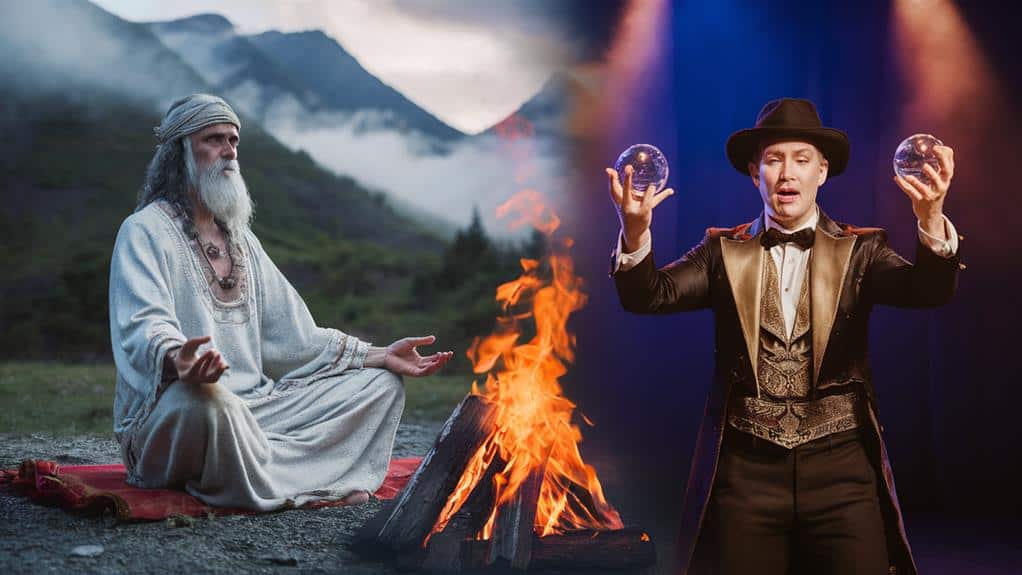
Understanding practitioners reveals another key distinction between magic and mysticism. When you examine magical practitioners, you’ll find they often position themselves as skilled technicians who’ve mastered specific formulas and rituals to achieve desired outcomes.
They’ll typically maintain a controlling stance, seeking to bend supernatural forces to their will through precise actions and incantations.
In contrast, mystical practitioners approach their practice with profound humility and surrender. You’ll observe how they don’t attempt to control divine forces but rather open themselves as vessels for spiritual transformation.
They’re more likely to engage in contemplative practices, meditation, and deep prayer, allowing themselves to be shaped by their encounters with the sacred.
You’ll notice that while magicians might offer their services to others, promising specific results through their craft, mystics often walk a solitary path, sharing their wisdom only when sought out by sincere seekers.
Their role isn’t to perform services but to serve as living examples of spiritual transformation. The mystic’s journey focuses on dissolving the ego rather than empowering it, marking a fundamental difference in how these practitioners approach their respective paths.
Modern Applications and Interpretations
The contemporary landscape has reshaped how we view and practice both magic and mysticism. You’ll find that modern practitioners have adapted ancient traditions to align with today’s technological and scientific understanding, creating unique hybrid approaches that bridge ancestral wisdom with contemporary needs.
In today’s world, you’re likely to encounter magic manifested through digital altars, online ritual spaces, and virtual communities, while mysticism often finds expression through mindfulness apps, meditation podcasts, and social media wisdom sharing.
You’ll notice that both paths have evolved beyond their traditional boundaries, with magic increasingly emphasizing personal empowerment and psychological transformation, while mysticism has become more accessible through secular spirituality movements and interfaith dialogues.
You’re witnessing a fascinating convergence where magical practices often incorporate scientific principles and psychological insights, while mystical traditions embrace modern neuroscience and quantum physics to validate ancient teachings.
This evolution hasn’t diminished their essential nature – rather, it’s expanded their relevance. Whether you’re drawn to ceremonial magic enhanced by digital tools or mystical practices supported by biofeedback devices, you’re participating in traditions that continue to adapt and thrive.
Conclusion
As you’ve explored the domains of magic and mysticism, you’ll recognize their distinct yet complementary paths to understanding reality. While magic empowers you to shape external forces through ritual and intent, mysticism guides you inward toward divine unity and self-transcendence. Together, they offer you profound insights into humanity’s eternal quest to comprehend and connect with forces beyond the ordinary, each illuminating different facets of spiritual exploration.



